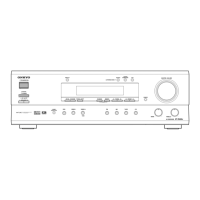29
To record the input source signal you are
currently watching or listening to
Recording of video and/or audio signals can be performed on the
components connected to the VIDEO 2 OUT and TAPE OUT
(audio only) jacks.
1. Press an input selector button to select the
input source to record.
The input source is now selected and you may watch or listen
to it as desired. The currently selected input source signal to
the TAPE OUT and VIDEO 2 OUT outputs for recording.
2. Start recording at the recording component as
desired.
Notes:
• You can record analog audio, but not digital audio. Make sure
that you have made a correct analog connection.
• If you change the input source during recording, you will
record the signals from the newly selected input source.
• You cannot record the surround effects.
• You cannot record the source connected to the MULTI
CHANNEL INPUT port.
Recording the video from one source and the
audio from another
You can add the sound from one source to the video of another
source to make your own video recordings.
Below is an example of recording the sound from a compact disc
player connected to CD L/R jacks and the video from a video
camera connected to VIDEO 1 IN VIDEO jack to video cassette
tape in a video cassette recorder connected to the VIDEO 2 OUT
L/R and VIDEO jacks.
Recording a source
STANDBY/ON
OFF
ON
POWER
MASTER VOLUME
BASS
TREBLE
AV
RECEIVER
HT-R490
FM
AM
C
D
TAPE
VIDEO
1
DVD
ABSPEAKERS
DIMMER
SURROUND
DTS/
VIDEO
2
VCR
AUDIO
SELECTOR
LISTENING MODE
DSP
STEREO
DISPLAY
STANDBY
SP SEL TUNING PRESET
MEMORY
SW
MODE
DIGITAL
INPUT
FM
MODE
CLEAR
1. Insert a CD in the CD player and insert a tape in
the video camera connected to the VIDEO 1.
2. Insert a video tape for recording in the video
cassette recorder connected to VIDEO 2 OUT.
3. Press the VIDEO 1 input selector button.
4. Press the CD input selector button.
This switches the audio output to CD, but the video output
remains VIDEO 1 that has been selected in step 3.
5. Start recording on the video cassette recorder
and start playing at the CD player and video
camera as desired.
The recorded video signal becomes the output from the video
camera and recorded audio signal becomes that from the CD
player.
Notes:
• You can record analog audio, but not digital audio. Make sure
that you have made a correct analog connection.
• If you change the input source during recording, you will
record the audio signals from the newly selected input source
and the video signals assigned to that input source.
• You cannot record the surround effects.
R
R
FRONT
CENTER
SURR
R
L
IN
OUT
VIDEO
CD
VIDEO 2
VIDEO 1
R
L
IN
MULTI
CHANNEL
Video
camera
CD player
1, 5
1, 5
Video cassette
recorder
2, 5
Input selector

